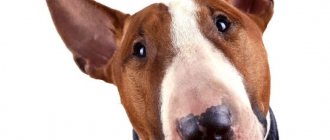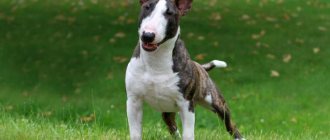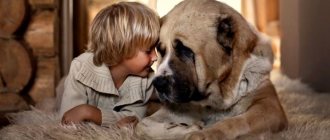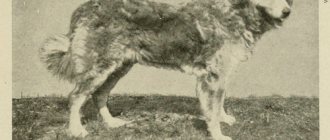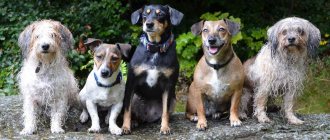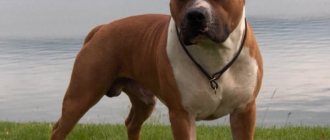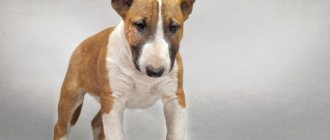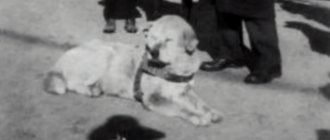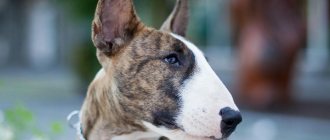The Bull Terrier is a dog breed shrouded in many myths and prejudices.
Some of them are due to the past of these animals, some due to their unusual appearance.
However, not everything you hear about representatives of this breed is true.
And many character traits and characteristics are completely different from common rumors.
Origin history and interesting facts
Bull Terriers are the result of the work of English breeders . After the ban on bullfighting was introduced in 1835, people began to need powerful, strong, fearless and hardy fighting dogs.
Bulldogs were too clumsy, so it was decided to breed new, more compact, agile and agile dogs with the strength and ferocity of bulldogs.
To achieve this, Old English Bulldogs were crossed with Terriers. This is how a new breed appeared - bull and terriers.
Since 1850, D. Hinks began improving the new breed, whose goal was to improve its exterior . To do this, he crossed Bull and Terriers with white Old English Terriers, Bulldogs, Greyhounds, Dalmatians and Scottish Collies.
The breeder presented the result of his work in 1862 at an exhibition in Birmingham - the snow-white dog had not only the best fighting qualities, but also an aristocratic appearance. To avoid confusion, Hinks named the new breed the Bull Terrier.
The new dogs captivated the British and soon became popular all over the world . In 1885, bull terriers were recognized by the American canine organization, and in 1898, a club of fans of this breed was created in the United States.
Description and standard
Bull Terriers are energetic, medium-sized dogs with a strong, dry constitution and an almost square body . They move confidently, smoothly and easily.
Representatives of this breed have pronounced sexual demorphism - males are larger, more powerful and more massive than females.
Breed standard:
- the head is ovoid, elongated, the lower jaw is clearly defined;
- the skull is rounded, sloping, the upper part between the ears is flat;
- the nose is large, the nostrils are developed, the earlobe is black;
- lips are dry and fit tightly to the jaws;
- scissor bite;
- the eyes are small, triangular, set obliquely and deeply, the iris is dark brown;
- the ears are small, V-shaped, erect, thin, set close to each other;
- the neck is strong, with well-developed muscles, long, arched, tapering from the shoulders to the head;
- the chest is wide;
- the back is short, strong, wide, straight;
- The loin is wide, slightly convex, muscular;
- tucked stomach;
- the tail is of medium length, thick at the base and slightly tapering towards the end, set low;
- the front legs are strong, even, the length is almost equal to the depth of the chest;
- The hind legs are set parallel, the thighs are well muscled.
The standard does not regulate the weight and height of bull terriers, but these dogs must be as powerful as possible for their size.
Character traits
There is a firmly entrenched stereotype in society that bull terriers are angry, unbalanced dogs prone to aggressive behavior.
However, despite their fighting past, they are cheerful, affectionate, playful and friendly animals, distinguished by their devotion and ability to find a common language with all family members.
Representatives of this breed are not characterized by aggression towards people . Such behavior has always been considered a serious fault and individuals in which it was observed were rejected.
Bull Terriers are smart and quick-witted dogs . They are highly trainable, but can sometimes be stubborn. Therefore, it is important to raise your pet correctly from an early age.
These dogs do not tolerate loneliness well. Out of boredom and idleness, he begins to look for a way out of his irrepressible energy through damage to property.
They need physical activity, regular active walks, including elements of training, running and other activities that allow them to get rid of energy and stay fit.
Bull Terriers will be excellent pets for active people who love sports and enjoy running . The owner of a bull terrier must be an experienced dog breeder with strong nerves, leadership qualities, patience and perseverance.
Expert opinion
Kozhevin Semyon Kirillovich
Expert dog handler.
Bull Terriers are a serious breed of dog, which, like no other, requires competent education and early socialization. Without training it is impossible to raise a well-mannered and balanced dog. If the owner is irresponsible in raising the pet, bull terriers grow up to be aggressive, extravagant and uncontrollable animals that can pose a danger to others.
Character traits
The Bull Terrier is a unique breed of dog that evokes tenderness and delight in some people, while in others it evokes a feeling of fear and danger. To understand whether a Bull Terrier poses a danger to humans, it is necessary to become familiar with the temperamental characteristics of representatives of this breed.
According to experienced dog breeders, the Bull Terrier is not suitable for those owners who dream of a calm and quiet pet. The dog requires attention: long walks, outdoor games, active physical activity. Regardless of its age, the animal is distinguished by its mobility and activity. With proper care, timely vaccinations and a well-organized diet, an old bull terrier can give a head start to many young dogs of other breeds.
Owners of animals of this breed note the incredible devotion of their pet, ready to defend its owner at any moment.
The Bull Terrier treats all family members with equal respect, but listens only to those who show strength of character. A dog, which by nature strives for dominance, wants to take a leading position in the family where it lives. For this reason, it is recommended to adhere to a single line of education. So, once you have established some kind of prohibition or rule, you need to comply with it on an ongoing basis.
The Bull Terrier, according to reviews from dog handlers, is not suitable for novice dog breeders who do not have practical skills and experience working with such dogs. Another dominant character trait of representatives of this breed is stubbornness. If the animal is not in the mood for training or some kind of physical activity, then only the inaccessibility and firmness of the owner can force it. Tenderness, affection and persuasion are unacceptable in raising these stubborn dogs.
Many people are afraid to get bull terriers, fearing contact between the child and the animal. A dog that is raised and trained from an early age will never harm children. The bull terrier will not only become a devoted friend of the child, but also his reliable protector.
However, in fairness, it must be said that children should not be allowed near an unfamiliar bull terrier walking on the street without a muzzle. A dog whose habits and upbringing are unknown can pose a danger to others.
Bull Terrier Jaws
Experts say that the force of compression of a bull terrier's jaws is 21-25 atmospheres.
The widespread belief that representatives of this breed have a so-called “death grip” is a myth.
The results of numerous studies have proven that these dogs do not have any special features in the structure of muscles or bones, and the ability to bite small objects and small animals without unclenching their teeth is explained by natural strength.
CAREFULLY!
You can only open the dog's jaw when it has grabbed the victim with a stick, using it as a lever, or a broken ampoule of ammonia - bull terriers cannot stand this smell.
Proper education and advice from dog handlers
An angry and aggressive dog is the result of improper upbringing or its complete absence.
Experienced dog handlers working with different breeds of dogs claim that an animal that grows in love will never show aggression towards others.
To prevent a dog from being dangerous, it is necessary to socialize it: walks in public places, communication with other animals and people, active games, physical exercises. Lack of socialization negatively affects the dog’s psychological state. At the slightest danger or uncertain situation, the bull terrier may attack another dog. The owner's task is to quickly navigate the area and find an object to which the leash can be firmly tied. Then you need to pull the leash so that the collar begins to squeeze the animal’s throat, making it clear that such actions are unacceptable.
For your own peace of mind and the safety of others, you should purchase a leash and muzzle for your Bull Terrier. It is not recommended to walk representatives of this breed in public places if the dog is not wearing a muzzle or is off a leash.
Advantages and disadvantages
In addition to their original, extravagant appearance, bull terriers have the following advantages::
- affectionate, friendly disposition;
- lack of aggression and anger towards people;
- lack of effort;
- strength and endurance;
- intelligence and intelligence;
- ability to learn;
- cleanliness;
- easy care;
- devotion.
Cons of the breed:
- the need for competent education and socialization;
- stubbornness;
- aggressive attitude towards other animals;
- tendency to overheating and sunburn;
- intolerance of loneliness.
In addition, representatives of this breed are not suitable as watchmen and security guards.
Description of the breed
It is really difficult to call representatives of this fighting breed ideal and problem-free. It is worth remembering that she was bred specifically to participate in bloody battles with her own kind. These competitions were brutal: the battle was considered over only after the death of one of the participants.
Naturally, strong, hardy, fearless, and passionate dogs were most valued. Only individuals with these qualities were allowed for breeding.
However, the result of such selection was unexpected: along with all the fighting characteristics, the dogs received an excellent mind, devotion to humans, excellent security qualities and a cheerful disposition.
As a result, the fame of the breed spread far beyond the circle of dog fighting fans. At home, in Great Britain, She quickly gained popularity, receiving the title of “gentleman”. Most of all, she was valued for her intellectual abilities, security qualities and sociable disposition.
The Bull Terrier is a sociable, active animal that will gladly take part in all fun games: fetch a ball, run after a bicycle, swim, take its owner on a sled. Physical activity is an indispensable condition for keeping such a dog. If the owner does not figure out how to make his pet exhausted, then he will find such a way himself: he will chew through the furniture, tear off his shoes, and turn the whole house upside down.
Fans of these dogs note their outstanding intelligence. They are always ready to learn. True, with one condition: if they categorically don’t like something, it’s better not to force it. Representatives of this breed are famous for their stubbornness and can react extremely negatively to excessive persistence. The process should give the four-legged student pleasure, then he will show results that exceed all his wildest expectations.
Today, bull terriers are most often used as guards. They are truly capable of protecting the owner and his home. And a bad reputation in this matter only plays into the hands of dogs: it is unlikely that anyone will decide to attack upon seeing such a “living killing machine.”
Types and their description
There are 3 types of bull terriers allocated by the FCI:
- English - fast and energetic dogs with a white coat, bred as a result of mating of a bulldog, terrier and Dalmatian;
- Staffordshire - energetic but slow animals that have significant exterior differences from English bulls; the coat can be brindle, black, red and white, brown, red and other colors;
- dwarf - a miniature copy of the English bull terrier with a coat of tri-color, white or yellow-brown color.
All these breeds are independent and only partly related to each other.
Color variations
In accordance with the breed standard, the skin pigmentation of bull terriers does not matter, and their coat can be:
- white - the most common color in which the coat is solid white, but markings of any color on the head are also acceptable;
- red - a coat of solid red color of any shade without spots or marks;
- black - as a rule, such dogs have small patches of white on their bodies, therefore, despite the predominance of black, the color is classified as bicolor;
- two-color - the wool is painted white and some other color;
- tricolor - coat of white, black and red (brown) colors;
- brindle - red fur with dark stripes, or vice versa, if there are white markings on the face, the color is called brindle-white.
Gray, fawn, blue bull terriers, as well as individuals with a white coat, whose colored spots are not located on the head, are not allowed for breeding.
Bull Terrier with children
If you have children and want to get a bull terrier, then you should remember that not just an animal, but another child will appear in your house. Such a dog should be given a lot of time and effort, so weigh the pros and cons carefully. The relationship between a bull terrier and a child will be the way you build it yourself. Accustom your dog to the fact that the child in your “pack” does not occupy the last place, the dog should be in last place. But this place needs to be shown not with kicks and screams, but competently. To do this, you will need to contact specialists.
Absolutely, you also need to teach your child how to communicate with animals.
Prohibit your children from tugging, pinching or otherwise offending the animal or causing it pain.
Is he good with children and does he get along with other pets?
Bull Terriers at home get along well with children, becoming excellent nannies for them. These dogs are patient and loyal to children's pranks.
Being cheerful and carefree animals, they quickly find a common language with kids and play with them with pleasure..
At the same time, it is better to get a puppy when there is already a baby in the family - this will help to avoid jealousy on the part of the dog and its attempts to regain the undivided attention of its owners.
IMPORTANT!
At first, communication between the dog and the child must be controlled - the child’s unceremonious behavior can provoke an inadequate reaction from the bull terrier.
Bull Terriers are fighting dogs, the desire to win and be leaders is genetically embedded in them.
Therefore, they cannot stand the competition that other pets create, and the natural instincts of these dogs sooner or later take over. When they see cats, bull terriers lose control and become uncontrollable; dogs see them only as objects of hunting.
Attitude towards children
Bull Terriers simply worship children. They perceive them both as participants in fun games and as objects for protection. However, there is no need to rush to bring such a dog into a family with a small child. Some character traits prevent them from becoming good nannies.
First of all, it is a lack of patience. Bull Terriers are not able to tolerate bad treatment.
If they start pulling their tail and ears, tugging too zealously, kicking them, then they will not tolerate it. Therefore, it is not recommended to ever leave this dog alone with a child. The behavior of both can be unpredictable.
Responding to the baby’s attacks, the bull terrier may not calculate its strength, and the fuss, which began as a fun game, may end in tragedy.
How to properly care
Bull terriers can live in an apartment without any problems, the main thing is the presence of the owner nearby and regular active walks . Moreover, these dogs are very heat-loving, and their short coat makes them unsuitable for outdoor living.
Wool and bathing
Bull Terriers should be brushed no more than 3 times a week using a stiff brush made of natural bristles - this improves blood circulation and gets rid of dust and minor dirt..
During seasonal shedding, you need to comb your pet daily with a special grooming glove.
Representatives of this breed must be bathed as they become dirty, maximum once a quarter, using a special mild shampoo for dogs.
Teeth
To avoid the appearance of plaque and tartar, you need to brush your pet’s teeth once a week with a special brush and toothpaste for dogs.
Eyes
Every morning, wipe with a cotton pad soaked in a special lotion or boiled water.
Claws
As a rule, the nails of adult dogs wear down on their own during walks . If this does not happen, they need to be trimmed every 3-4 weeks with a guillotine nail clipper so as not to touch the blood vessels.
Ears
Clean the inside of your ear weekly with a damp cotton pad. Do not use cotton swabs - any careless movement can lead to hearing loss for your pet.
How dangerous is a bull terrier?
The main danger of this fighting dog lies in its enormous strength. It naturally contains huge reserves that allow it to win victories even in fights with animals that are much larger than the dog in size.
Even the characteristic appearance of this breed testifies to the power hidden in it: a wide chest, a large square body, short massive paws.
The dog's jaws deserve special attention. They easily chew even the largest bones. At the same time, bull terriers have a death grip: having grabbed onto the enemy, they will instinctively continue to clench their jaws until the victim stops showing signs of life.
These dogs are also distinguished by their agility, mobility and even grace. When attacked, they are able to quickly assess the situation, make decisions and just as quickly implement them. Thanks to these qualities, they gained fame as excellent guards and dangerous killer dogs.
The Bull Terrier is a dog for strong people. It is recommended to get one for adult men who can immediately show this fighting dog its place in the pack. As soon as the dog feels weak, he will immediately try to win the title of leader. Therefore, when communicating with her, you should not make annoying mistakes. A dog can decide to reconsider the distribution of roles in its “pack” if the owner:
- hurt him greatly, punished him unfairly, hit him,
- treats him with disdain: this dog has a sense of self-esteem, and this cannot be neglected,
- often loses his temper and screams. It will not be possible to intimidate a dog this way. On the contrary, she considers a person who constantly raises his voice to be weak and soft-spoken,
- pays little attention to the dog.
The best style of behavior with a Bull Terrier is confident calm. In such conditions, the dog will feel comfortable and will not demonstrate the desire to gain the position of leader.
An important condition for good behavior of a pet is regular physical activity. He needs to walk at least 1.5 hours a day every day. Moreover, these should be active walks. This dog prefers to frolic not on its own, but in the company of its owner. A person who tends to lead a sedentary lifestyle simply cannot do this. A bull terrier, forced to live passively, can become uncontrollable, irritable and aggressive.
A dog of this breed is a bad neighbor for other animals. It is worth remembering that this one was bred to kill its own kind, so it is unlikely to be able to get along in the same house with other four-legged animals. Leaving animals alone unattended in the company of such a dog means exposing them to serious danger.
Any little thing can make a dog lose patience: encroachment on its territory, too “arrogant” approach to the bowl, etc.
A bull terrier may even try to get into fights with other dogs while walking. You can protect others from danger only through education. From a very young age, the dog must be made to understand that aggression is unacceptable and even the slightest manifestations of it must be harshly suppressed.
Health and major diseases, life expectancy
On average, bull terriers live 10-15 years.
Representatives of this breed have good immunity and good health, but there are a number of diseases, the predisposition to which is due to genetics:
- deafness;
- acrodermatitis;
- copper toxicosis;
- blepharophimosis;
- hypoplasia of the larynx;
- cleft palate and upper lip;
- dislocation of the elbow and kneecaps;
- hip dysplasia;
- polycystic kidney disease;
- inversion and inversion of the eyelid;
- hypothyroidism;
- bicuspid heart valve dysplasia;
- epilepsy;
- obsessive-compulsive disorder;
- astigmatism;
- aortic stenosis.
As Bull Terriers age, the risk of developing mammary sarcoma and mastocytoma increases..
In addition, these dogs have very delicate skin, which is why in the summer they are at risk of sunburn, and are prone to developing allergic skin reactions - even a mosquito bite can cause itching, rashes and hives.
Nutritional Features
The Bull Terrier's diet can be based on industrial feed or natural products.
Each owner independently determines what the dog’s nutrition will be; the main thing is not to mix both types of feeding and ensure that the diet is balanced, nutritious and includes all the necessary vitamins, macro- and microelements.
Natural nutrition allows the owner to independently control the quality of food consumed by the pet and diversify the diet as much as possible.
With this type of feeding, the menu must include:
- lean meat;
- chicken or beef by-products;
- boiled sea fish;
- seasonal vegetables and fruits, herbs;
- raw eggs;
- vegetable oils;
- dairy products;
- cereals
You can give your pet hard cheese as a treat.
It is necessary to additionally give the bull terrier a vitamin complex, and up to 18 months - calcium.
Representatives of this breed are prohibited:
- fat meat;
- smoked meats, pickles, marinades;
- sweets, chocolate;
- seasonings;
- River fish;
- spicy and fried foods;
- bakery and pasta products;
- legumes
If the diet is based on ready-made food, it must correspond to the age, physiological state and health of the pet.
You should not skimp on feeding your bull terrier and purchase economy class food - these dogs are suitable for products of at least premium class.
The most suitable brands of food for representatives of this breed are Orijen, AATU, Applaws, Acana, Bozita, Solid, Genesis, GO!, Grandorf.
Bull Terrier Exposed: What's Hidden Behind Its Bad Reputation
It is probably difficult to find a dog breed around which so many different prejudices revolve. A living weapon, an incredibly aggressive beast with a monstrous clenching force in its jaws, a real threat to others, and first of all, to its own masters! As you probably guessed, all these epithets can be heard addressed to the bull terrier. The specific appearance of the animal, which does not quite correspond to a person’s idea of a cute pet, played a certain role in creating a negative image. However, is this really so? Today we will have the opportunity to understand this issue in more detail.
Photo: @cheredanya
As can be understood from the name, the bull terrier is a cross between the breeds of the same name - bulldog and terrier, with a slight “admixture” of several other dogs. The breed saw the light of day in the middle of the 19th century. Its founder is considered to be the English dog breeder from Birmingham James Hinks , who first presented his creation to the world at an exhibition in 1862. Since then, the appearance of the bull terrier has been somewhat adjusted - the features of its ancestors were carefully derived from it, and a completely unique image was created. Thanks to the efforts of specialists, today this dog is one of the most recognizable in the world. @cheredanya kindly agreed to tell us about the life, maintenance and upbringing of one individual bull terrier . And her devoted pet Taras will help her with this.
Photo: @cheredanya
- Hello Anya! Hello Taras! Today I dare to break the tradition of our surveys, because I want to dispel accumulated prejudices in advance. Let's start with character. Taras - what is he like? Does his nature match the supposed killing machine?
- Well, if only we are talking about killing time)). The character of any dog, regardless of breed, depends on its upbringing. Everything that the owner puts into her from childhood and will be reflected in her future behavior. The “black legend” about bull terriers did not appear out of nowhere - they are often perceived and raised as fighting dogs. Undoubtedly, this breed has a predisposition to blood sports, but, if desired, any animal can be turned into a monster. The main thing is to set yourself such a goal. When we took little Taras into our care, we set ourselves the exact opposite goals.
Photo: @cheredanya
— How did Taras come into your family?
— A white bull terrier has been my husband’s long-time dream. I always just wanted to have a dog, but my work schedule did not allow me to raise it. It’s easier for my husband in this regard, he has a daily schedule and has time to take care of the pet. And so it happened.
Photo: @cheredanya
—Where did you find the puppy?
“I looked through various sources on the Internet, and quickly enough I found exactly what we wanted. My husband and I live in Moscow, but we had to pick up the puppy all the way from St. Petersburg! Moreover, he was picked up very quickly, because he was the last one left - the entire litter had already been sorted out. Since my husband was working, I had to go to St. Petersburg - I literally hitched a ride there. We met the puppy's owner at the metro station. I almost shed a tear when I saw a small, defenseless lump in her arms. Everything went well, but there was still a long way home. How will such a baby bear it? However, my fears turned out to be in vain - during a couple of technical stops, I lowered him onto the grass, and Taras successfully went to the toilet. Moreover, the puppy was consciously waiting for the next stop - even then he was a well-mannered guy!
You'll like it:
- How to train a dog not to make noise in the home office? Catch a life hack!
- Two pit bulls who stole my heart: adopting a baby squirrel and sheltering a pregnant cat
- Cure for depression in self-isolation: Anthony Hopkins and his cat... play music
- The Incredibles: two golden retrievers, huskies and kittens!
- 14 photos that will significantly improve your day!
Photo: @cheredanya
- Let's talk more about his character. I take it he doesn't look particularly like a trained fighting bull terrier?
- Exactly. The only character trait that Taras can call typical for this breed is incredible stubbornness. We trained him well enough, and he understands perfectly well what his owners want from him, but he’s just in no hurry to do it. Indeed, you need to carefully evaluate and think about everything? The owner is the owner, but he has to strain himself! Otherwise, this is an incredibly affectionate and friendly animal, and not only with us. Even strangers evoke an inexplicable feeling of tenderness in him - if you don’t keep track of Taras, he may well follow someone! Some people are wary of it, and then are incredibly surprised, gaining a new appreciation for a breed with a bad reputation. Well, as a “cherry on the cake”, so that you get a complete picture of our “killing machine” - Taras is incredibly lazy. He will definitely prefer a sound and healthy sleep to a good walk. Therefore, more often than not, it is we who take the initiative in this regard. Some owners complain that during a walk the bull terrier pulls them forward too much. Taras, on the contrary, constantly slows down our movement, like an anchor.
Photo: @cheredanya
Photo: @cheredanya
It is hard to believe! Here's a fighting dog for you! It turns out that with a certain upbringing, even a bull terrier can be raised into a cute animal?
- Certainly. I will repeat once again that I do not particularly believe in the aggressive predisposition of a certain breed. If a person consciously raises a fighting dog, he will get one. And such a pet, if not kept correctly, can really pose a danger to others. But we didn’t prepare our Taras for dog fights. He has other advantages.
Photo: @cheredanya
Photo: @cheredanya
- I convinced you. )) What can you say about the content? Does your bull terrier cause a lot of trouble?
- Enough - of course, if you carefully take care of your pet. However, this is a matter of habit. Look, it would seem, why should Taras molt? However, in this case, appearances are deceiving - our boy has a fairly abundant undercoat, which in the warm season forces him to brush regularly. I heard that not all bull terriers suffer from this, but we got exactly the “woolly” individual. Therefore, Taras is not friends with spring and summer - winter is much more pleasant to him. Another problem is that his claws are very brittle, he periodically tears them off and suffers greatly from this. We carefully ensure that the wound is disinfected in a timely manner; we always have a dog first aid kit at hand. Unfortunately, Taras is not distinguished by excellent health - digestive problems periodically arise, tartar bothers him, and infections and overeating cause skin diseases and otitis media. That is why monitoring his well-being is an important part of our lives. Can you imagine what I experienced when Taras fell into a wormwood one winter!
Photo: @cheredanya
Photo: @cheredanya
- Did you fall into the wormwood?! Well, tell me more, it’s interesting!
- And it was so interesting for me! Once I was walking with Taras along the Yauza River - it was in January, it was about five degrees below zero outside. He ran about his business behind the bushes and suddenly I heard a splash of water! I'm going there. I look - one of Taras’s heads is sticking out of the water, and his paws are vainly scratching on the ice around the hole. The situation is shocking for me - I know that our pet does not know how to swim... There is no time to think - I had to go to the aid of a drowning man! Swim. Despite the time of year, I didn’t feel the cold at all, my only thought was to get to Taras as quickly as possible! There was also nothing to lean on - the bottom turned out to be muddy and unreliable. By some miracle I reach the animal, shoulder almost 27 kilograms of live weight and heroically drift towards the shore. At some point I even thought that I wouldn’t be able to get out of Yauza... But everything turned out okay. Already on the shore, I ran into a passerby who was dumbfoundedly watching what was happening. Having assessed my condition, he advised me to return home - it was necessary, but I just dreamed of continuing my walk! )) It was about ten minutes to the house, Taras and I returned wet and tired, under the amazed looks of passers-by. And as soon as we crossed the threshold, we went straight into a hot shower, together with our pet! It all worked out - neither he nor I even caught a cold.
Photo: @cheredanya
“You really risked your own life for the sake of the dog!”
- Taras deserves it. I simply could not live in peace knowing that I left him there to die.
Photo: @cheredanya
Photo: @cheredanya
- I think, like most good owners.
- Good ones, yes. True, we still had to become good owners - including through trial and error. For example, understanding the features of their physiology. By the way, there is another funny story connected with this. Taras is our first dog, so we learned about the peculiarities of her behavior in “real time”. Somehow, during a walk in the sandbox, Tarasik became very overexcited - in all respects, and revealed his small, but already very impressive dignity. Frankly speaking, I never knew or was interested in what it looks like “live”. Therefore, the first appearance of the “pod” to the people, accompanied by excessive swelling of the veins, seemed abnormal to me. Today it’s funny and uncomfortable to remember this, but then I was really scared, and in all seriousness tried... to put some of the excess back into the dog. It’s scary to even imagine how Tarasik felt at the same time. Later, my husband and I figured out the nuances of dog anatomy, and the incident in the sandbox added to our family’s collection of funny stories. But the main thing is that not a single dog was harmed as a result of the incident!
Photo: @cheredanya
- Poor Taras! )) The main thing is that it all ended without any unpleasant consequences. But let's get back to the specifics of keeping - what do you feed your pet?
“At first we experimented with a variety of foods, including natural food, but today we confidently switched to dry food - it has everything Taras needs, and most importantly, it is the only food that is the most harmless for the dog. Especially considering health problems.
Photo: @cheredanya
Photo: @cheredanya
- It's clear. Is Taras your only pet, or are there other animals in the house?
— We also have a cat named Matvey, a sphinx. They got along quite well in character and coexist perfectly according to the principle of mutual non-interference. At the same time, Taras shows special tact towards his neighbor. Matvey first approaches the bowl of water, and the dog patiently waits for him to finish drinking. In addition, my husband and I dream of an Oriental cat, but we don’t have one in our plans in the near future.
Photo: @cheredanya
— Anh, thank you for the great conversation! We worried, laughed, thought with you. As a conclusion, you have the opportunity to say a few words to our readers.
- Thank you! In principle, I can repeat once again what I have already said. There are no evil or good breeds - there are appropriate conditions of detention and methods of education. So that the dog’s behavior does not come as a surprise to you, you need to pay more attention to it, reacting to any changes in the animal’s character. It is attention and care that underlie the harmonious relationship between the owner and his pet. Appreciate your dog, and he will certainly reciprocate the same!
You can continue watching cute Taras in Anya’s incredibly stylish profile:
View this post on Instagram
Post from Pogodka
